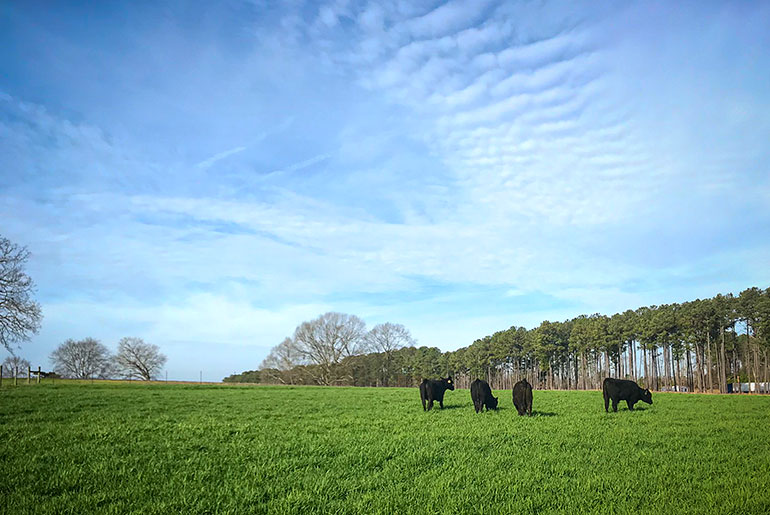News
The information presented on this page may be outdated. It may refer to situations which have changed or people who are no longer affiliated with the university. It is archived as part of Mississippi State University's history.
Mississippi State scientists study cattle grazing cover crops

Cattle graze cover crops at the MAFES Coastal Plain Branch Experiment Station. (Photo By: Submitted)
3/8/2022
By: Grace Jones
Brett Rushing, Mississippi State University associate extension and research professor in plant and soil sciences, and Josh Maples, MSU assistant professor in agricultural economics, analyzed different cover crops species integrated within a livestock grazing system. The two-year research project, based at MSU's Mississippi Agricultural and Forestry Experiment Station Coastal Plain Branch in Newton, established row crops and cover crops that encompassed a variety of species suitable for grazing that led to increased livestock weight gain.
The team had cattle graze the cover crops rather than tilling to prepare for spring planting. With this no-till approach, researchers were aiming to combine positive attributes of growing cover crops in intensively managed row cropping systems with the ability to produce high animal weight gains.
"We approached this research with a complete no-till management system with the cover crops and row crops, designed to assess the impacts of management on soil health," Rushing said.
The first crops, planted in October 2019, had a strong growth response, despite crop delay due to heavy rain. A freeze in February 2020 damaged some of the oat cover crops. Since environmental conditions compressed the grazing season, which kept the research from capitalizing the grazing window, the overall benefits were not entirely captured within the first two years of the research.
Despite delays, the team was able to analyze specific improvements of their research. While analyzing the different paddocks, the researchers found that the soil of the grazed crops increased in organic matter.
"Our tilled soils were under one percent of organic matter, where our grazed areas were at one and a half percent," Rushing said. "We are definitely starting to see how grazing benefits organic matter, and with the South's environmental conditions, increase in organic matter by half of a percent in two years is pretty significant."
Maples, who oversaw the economics of the project, noted that the research approach and focus differ from other cover crop research being conducted throughout the nation.
"The idea that we could marry two systems like cover crop production and grazing livestock and have economic benefits with this integrative approach is not something producers are incorporating in this region," Maples said. "So, we approached this research by focusing on the impact the cover crops had on the row crops themselves, and we studied the impact that the crops had on animal weight and then measured the productivity we had for all those systems."
After the preliminary data analysis, Maples said the initial findings suggest some crops were more economically beneficial than other mixed species cover crops. This result has shown the researchers what kind of cover crop mixes will be more successful than others, information they'll pass on to producers.
While the two-year project is finished, the scientists are excited to start the study's next phase.
"This research is relevant, and we are getting to apply it directly to what producers ask us every day," Maples said. "Studying these crops for a longer term, along with the market and production system changes, will provide more applicable results that can help producers maintain successful cropping systems."
New research projects will begin this spring and will be conducted on other MAFES branches, including the Prairie Research Unit in Prairie and the Brown Loam Branch Experiment Station in Raymond. The scientists will focus on cereal rye as the cover crop treatment, along with evaluating soil benefits through a biological lens. The analysis will assess chemical, biological and physical benefits like organic matter, carbon sequestration and available phosphorus throughout the cover crop growing season. By continuing the research, it is the team's goal to provide impacts to improve producers' bottom line.
Through its 16 branch experiment stations, the Mississippi Agricultural and Forestry Experiment Station conducts research to benefit farmers throughout the state. To learn more, visit www.mafes.msstate.edu.
View More News